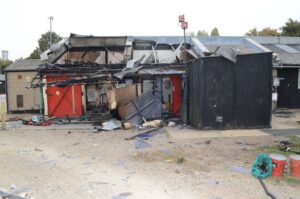Stay safe around cattle in the countryside at Easter
The Easter break will see thousands of people heading into the countryside to stretch their legs and enjoy Britain’s stunning scenery.
While the vast majority of walkers enjoy the countryside safely and use the extensive network of footpaths, bridleways, and public access land without any problems, going through fields where there are cattle can be hazardous.
Britain’s workplace regulator, the Health and Safety Executive (HSE), is reminding both farmers and walkers to do all they can to help to keep everyone safe, particularly where cattle and countryside visitors are close together.
HSE inspector Wayne Owen said: “All large animals can be a risk to people. Even a gentle knock from a cow can result in people being crushed or falling. All cattle should be treated with respect.”
Farmers have a legal responsibility to manage their herds to reduce risk to people using footpaths and other rights of way.
HSE regularly investigates incidents involving cattle and the public. A proportion of these incidents involve serious injury and sometimes death. On average, between one and two members of the public are killed each year while using public rights of way, others suffer serious injury.
Incidents in which walkers are killed or injured often involve cows with calves, or bulls. Often, those injured or killed have a dog with them.
Members of the public can find out about steps to safely enjoy the countryside and respect farming activities by following Government advice in The Countryside Code – GOV.UK (www.gov.uk).
Advice includes:
- Give livestock plenty of space. Their behaviour can be unpredictable, especially when they are with their young.
- Keep your dog under effective control to make sure it stays away from livestock. It is good practice wherever you are to keep your dog on a lead around livestock.
- Let your dog off the lead if you feel threatened by livestock. Releasing your dog will make it easier for you both to reach safety.
Mr Owen said: “Farmers should carefully consider the risk before putting cattle into fields with footpaths, for example cows and calves are best kept in alternative fields.
“Even docile cattle, when under stress, perhaps because of the weather, illness, unusual disturbance, or when maternal or other instincts are aroused, can become aggressive.
“Follow farming industry and HSE guidance to reduce the risk from animals and help people to enjoy your land and pass through smoothly.”
Key considerations for farmers and landowners include:
- No dairy bulls should be kept in fields with public access at any time.
- Where possible avoid putting cattle, especially cows with calves, in fields with public access.
- Where there is a need to keep cattle with calves or a bull in a field with public access, do all that you can to keep animals and people separated. Consider the use of fencing (permanent or temporary e.g. electric fencing). This is particularly important at busy times or where access routes are heavily used.
- Assess the temperament of any cattle before putting them into a field with public access.
- If cattle, especially cows with calves, do need to be put into fields with public access, keep this period to a minimum.
- Position feed and water troughs away from public access routes and away from public entrances and exists to the field.
- Put in place a system to monitor any cattle in fields with public access at least on a daily basis. It may be worth recording this.
- Consider culling any animal that shows signs of aggression.
- Any animal that has shown any sign of aggression must not be kept in a field with public access.
- Clearly sign post all public access routes across the farm. Display signage at all entrances to the field stating what is in the field (cows with calves / bulls).
Notes to editors
- HSE Guidance for England and Wales on putting cattle into fields with public rights of way / public access can be found here: Cattle and public access in England and Wales (hse.gov.uk)
- HSE guidance for Scotland can be found here: Cattle and public access in Scotland: Advice for farmers, landowners and other livestock keepers AIS17 (hse.gov.uk).
- There is also guidance available from other stakeholders for visitors to the countryside and farmers / landowners eg The Countryside Code – GOV.UK (www.gov.uk).
- The Health and Safety Executive (HSE) is Britain’s national regulator for workplace health and safety. We prevent work-related death, injury and ill health through regulatory actions that range from influencing behaviours across whole industry sectors through to targeted interventions on individual businesses. These activities are supported by globally recognised scientific expertise.
- Further details on the latest HSE news releases.


